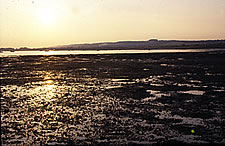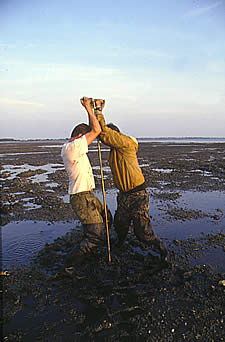50.81103, -1.030884

Not all of Wessex Archaeology’s projects involve digging through solid ground. One of our most unusual projects was at Langstone Harbour near Portsmouth, where our archaeologists worked for seven years in deep mud and treacherous tides.
The team found remains which dated back to the 8,500BC at the Harbour – described by one archaeologist as “a mysterious backwater – at high tide a great, almost land-locked lagoon of salt water, at low tide an expanse of grey mud.”
The work was important as the small islands within Langstone Harbour are eroding rapidly and the remains had to be recorded and interpreted before the sea washed them away forever. The unusual conditions made things easier as well as harder: many flints and pieces of pottery were found on the foreshore as erosion of the islands by the sea exposed them.

Their work completely rewrote the history of the area. They showed for the first time that Langstone was not a harbour at all in prehistoric times, but an area of open grassland and woods where people came to collect flint for making into tools, to hunt animals and to graze sheep and cattle. By the Iron Age (700BC) the sea began gradually seeping in and this allowed people to make salt and farm oysters. Their finds included Neolithic waterlogged trees dating to 3,000BC, pieces of Bronze Age pottery (c1,200BC) and a medieval harpoon (c AD 1300).
By Saxon times (5th century AD) the harbour was fully formed and boats were used to cross it. During recent survey work by the Hampshire and Wight Trust for Maritime Archaeology a Saxon boat was found in the muds and our team – Dr Mike Allen and Dr Julie Gardiner – was filmed for the Past Finders TV Programme examining it and discussing the archaeology of the area.
Langstone was a dangerous place to work, with fast running tides that sneak in from behind the small islands in the harbour and cut off the unwary from shore. Strict safety measures had to be observed at all times by our team, who carried ropes and flares. Their caution paid off as no one came to any harm.
Our staff were part of a team that included maritime archaeologists from Southampton University and the Hampshire and Wight Trust for Maritime Archaeology, and geographers from Portsmouth University. The team, which also included local fisherman Arthur Mack, carried out underwater surveys and searches as well land excavation.
Those interested in learning more about this excavation should read:

Our Changing Landscape; an intertidal survey of Langstone Harbour,Hampshire
by Allen.M.J. and Gardiner, J. 2000.
York, Council for British Archaeology (CBA) Research Report 124 - £32 from